Gekisai Dai Ichi
Gekisai Dai Ni
Saifa
Seiunchin
Shisochin
Sanseiru
Seipai
Kururunfa
Seisan
Suparinpei
Sanchin Dai Ni
Tensho
Gekisai Dai Ichi (to smash and destroy part 1)
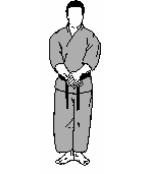 Gekisai Dai Ichi is the first of the introductory kata which were created by Miyagi Sensei. Said to have been created around 1940, Miyagi Sensei intended to use these kata to instil an interest in new practitioners and school children. Up until this time, a student would have only been taught sanchin and one of the kaishu kata which would have been chosen for their personal study due to their physical attributes and personality.
Gekisai Dai Ichi is the first of the introductory kata which were created by Miyagi Sensei. Said to have been created around 1940, Miyagi Sensei intended to use these kata to instil an interest in new practitioners and school children. Up until this time, a student would have only been taught sanchin and one of the kaishu kata which would have been chosen for their personal study due to their physical attributes and personality.
Miyagi Sensei was concerned for the future growth and preservation of karate do, and so by creating these kata, he sought to promote and popularise karate through the school system.
Miyagi Sensei is said to have taken his inspiration for the development of Gekisai from his 1936 visit to China where he visited the Jing Wu academy. The Jing Wu school was working to promote and preserve the Chinese martial arts by collectively gathering the various arts under one roof and working to restore them to their former standing.
The Gekisai kata contain techniques taken from the other 8 kaishu kata, as well as techniques not contained elsewhere in the goju ryu system such as Age Uke and Oi Jodan Tsuki. The inclusion of these techniques may suggest a slight Shorin Ryu influence, and it is commonly said that Miyagi Sensei was in close consultation with Mabuni Kenwa (shito ryu) and Nagamine Shoshin (shorin ryu) during the creation of the Gekisai kata.
Containing a number of different striking techniques, kicks, takedowns and combinations, the Gekisai kata are more than a mere introduction to Goju Ryu. They stand alone as fighting kata in their own right, and offer an insight into the kind of ideas Miyagi Sensei was working on around the period of 1940.
Gekisai Dai Ni (to smash and destroy part 2)
 As above, but now with the inclusion of kake uke, advancing and retreating before suddenly making up ground to strike. Also introduces mawashi uke and a unique way of stepping in neko ashi dachi which does not appear in any other of the goju ryu kata.
As above, but now with the inclusion of kake uke, advancing and retreating before suddenly making up ground to strike. Also introduces mawashi uke and a unique way of stepping in neko ashi dachi which does not appear in any other of the goju ryu kata.
Saifa (to smash and tear)
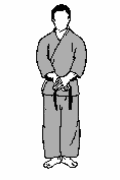 Saifa is said to have been brought back from Fuzhou China by Higaonna Kanryo Sensei. The kata contains close range techniques designed to disrupt the opponents balance before pulling onto various strikes such as ura ken or tetsui uchi. Saifa contains a number of hidden techniques designed to hide their true application.
Saifa is said to have been brought back from Fuzhou China by Higaonna Kanryo Sensei. The kata contains close range techniques designed to disrupt the opponents balance before pulling onto various strikes such as ura ken or tetsui uchi. Saifa contains a number of hidden techniques designed to hide their true application.
The kata is characterised by light, quick footwork and fast strikes using different parts of the hand. Despite the kata's brevity there is a real depth of technique to explore, and numerous techniques and strategies which are unique to this kata.
Seiunchin (to grasp and pull off balance)
or (marching far quietly)
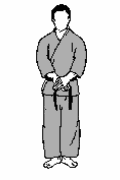 Seiyunchin
Seiunchin is a powerful kata which beautifully demonstrates the blend of hard and soft. The kata consists of close quatered striking, sweeps, takedowns and throws, and involves extensive use of the shiko dachi stance. Again, it is a close range kata, the strategy of which is designed to stick to your opponent at close range and employ techniques such as uppercuts, backfists and strikes to the vital areas in order to control your opponent. It also includes ways in which to recover that close range should the opponent suddenly retreat.
Seiyunchin
Seiunchin is a powerful kata which beautifully demonstrates the blend of hard and soft. The kata consists of close quatered striking, sweeps, takedowns and throws, and involves extensive use of the shiko dachi stance. Again, it is a close range kata, the strategy of which is designed to stick to your opponent at close range and employ techniques such as uppercuts, backfists and strikes to the vital areas in order to control your opponent. It also includes ways in which to recover that close range should the opponent suddenly retreat.
Shisochin (to battle in four directions)
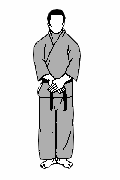 Shisochin kata was said to have been a favourite of Chojun Miyagi Sensei. The kata includes the use of nukite fingertip strikes to the vital areas, arm bar techniques, and ways to quickly close the distance and bring the fight back to that close range favoured in the Goju Ryu system. The kata is said to be ancient, and researchers suggest that it may have been demonstrated at the 1867 demonstration of martial arts at the Ochayagoten of Shuri Castle, where a kata called Chishaukiun was demonstrated by Aragaki Seisho. It has been suggested that Chishaukiun could have been another pronunciation for Shisochin.
Shisochin kata was said to have been a favourite of Chojun Miyagi Sensei. The kata includes the use of nukite fingertip strikes to the vital areas, arm bar techniques, and ways to quickly close the distance and bring the fight back to that close range favoured in the Goju Ryu system. The kata is said to be ancient, and researchers suggest that it may have been demonstrated at the 1867 demonstration of martial arts at the Ochayagoten of Shuri Castle, where a kata called Chishaukiun was demonstrated by Aragaki Seisho. It has been suggested that Chishaukiun could have been another pronunciation for Shisochin.
Sanseiru (thrity six hands)
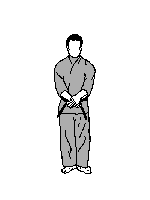 Sanseiru is said to have been one of the original kata taught by Higashionna Kanryo Sensei. Sanseiru is also preserved in a slightly different version in the To'on Ryu system of Juhatsu Kyoda Sensei, who was Miyagi Chojun Sensei's Sempai. Kyoda Sensei learnt this kata in the absence of Miyagi Sensei whilst Miyagi Sensei was serving with the Japanese army.
Sanseiru is said to have been one of the original kata taught by Higashionna Kanryo Sensei. Sanseiru is also preserved in a slightly different version in the To'on Ryu system of Juhatsu Kyoda Sensei, who was Miyagi Chojun Sensei's Sempai. Kyoda Sensei learnt this kata in the absence of Miyagi Sensei whilst Miyagi Sensei was serving with the Japanese army.
Practised in varying ways by different Goju Ryu schools, some including a jump kick, sanseiru uses ways where the fighting distance is quickly reduced before striking the opponent with multi level combinations in order to control him. Sanseiru also includes a number of throws and low range kicking techniques designed to disrupt the opponents balance.
Seipai (18 hands)
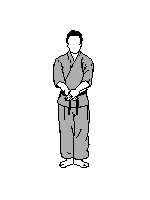 Seipai kata makes use of sharp hip twists to generate power into fast whipping strikes. Seipai includes a number of throws and hidden techniques in order to subdue an opponent. The title '18 hands' may relate to the Monk Fist system (18 Lohans, thought to have been the first form of Shaolin Chuanfa)
Seipai kata makes use of sharp hip twists to generate power into fast whipping strikes. Seipai includes a number of throws and hidden techniques in order to subdue an opponent. The title '18 hands' may relate to the Monk Fist system (18 Lohans, thought to have been the first form of Shaolin Chuanfa)
Kururunfa (holding ground) (come, stay, the waves) or (Forever stops, peacefulness and Tearing)
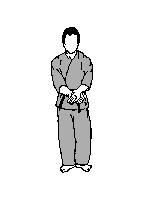 No exact translation for this kata is known, the above relates to commonly accepted versions. Kururunfa has a number of unique techniques, found only in this kata. Two techniques worthy of particular attention are an escape from a rear full nelson, and an irish whip throw. Many grappling and throwing manoeuvres are concealed within the kata.
No exact translation for this kata is known, the above relates to commonly accepted versions. Kururunfa has a number of unique techniques, found only in this kata. Two techniques worthy of particular attention are an escape from a rear full nelson, and an irish whip throw. Many grappling and throwing manoeuvres are concealed within the kata.
Seisan (thirteen hands)
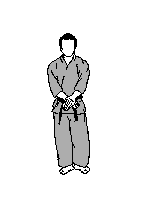 Another of the kata said to have been from Higashionna Kanryo Sensei's original Naha Te system. The origins of Seisan are ancient with versions in both the Naha and Shuri branches. Seisan kata was demonstrated at the 1867 demonstration of martial arts by Aragaki Seisho and was at that time known by the name of Jusanpo. Seisan is a great self defense kata and contains some of the most deadly techniques of the Goju Ryu system. Seisan kata is said to have been a favourite of Miyagi Sensei and Shinzato Jinan sensei.
Another of the kata said to have been from Higashionna Kanryo Sensei's original Naha Te system. The origins of Seisan are ancient with versions in both the Naha and Shuri branches. Seisan kata was demonstrated at the 1867 demonstration of martial arts by Aragaki Seisho and was at that time known by the name of Jusanpo. Seisan is a great self defense kata and contains some of the most deadly techniques of the Goju Ryu system. Seisan kata is said to have been a favourite of Miyagi Sensei and Shinzato Jinan sensei.
Suparinpei (108 hands) also known as Peichurin
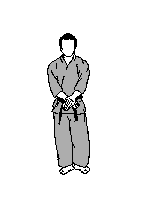 Again, said to have been one of the original kata of Higashionna Sensei's Naha Te system. Suparinpei was demonstrated at the 1867 demonstration by Tomura Chikudon Peichin and so can be traced back at least to that period. A common theory for the name Suparinpei is that it relates to Buddhist symbolism in that humans are born with 108 evil desires that they must seek to rid themselves of. Another theory is that it may be a reference to the 108 striking points on the human body as described in the bubishi.
Again, said to have been one of the original kata of Higashionna Sensei's Naha Te system. Suparinpei was demonstrated at the 1867 demonstration by Tomura Chikudon Peichin and so can be traced back at least to that period. A common theory for the name Suparinpei is that it relates to Buddhist symbolism in that humans are born with 108 evil desires that they must seek to rid themselves of. Another theory is that it may be a reference to the 108 striking points on the human body as described in the bubishi.
The Suparinpei kata moves through all eight directions of the compass and includes a number of techniques unique to this kata, including a 360 degree kick followed by a jumping kick.
Sanchin (three battles/conflicts)
 Commonly said to relate to the three internal battles between mind, body and spirit, Sanchin tries to offer a way in which to resolve these conflicts. A basic, but very difficult kata to perform well, Sanchin is a breathing kata, the aim of which is to co-ordinate breath with movement while maintaining the correct structure of the body. Sanchin was originally performed with open hands, utilizing nukite fingertip strikes. Higashionna Sensei felt that changing open hands to closed fists would be more suited to Okinawan practitioners who were used to striking with a closed fist.
Commonly said to relate to the three internal battles between mind, body and spirit, Sanchin tries to offer a way in which to resolve these conflicts. A basic, but very difficult kata to perform well, Sanchin is a breathing kata, the aim of which is to co-ordinate breath with movement while maintaining the correct structure of the body. Sanchin was originally performed with open hands, utilizing nukite fingertip strikes. Higashionna Sensei felt that changing open hands to closed fists would be more suited to Okinawan practitioners who were used to striking with a closed fist.
Two versions of Sanchin are practised, preserving both the Sanchin of Higashionna Sensei and the version, without turns, as taught by Miyagi Sensei.
Tensho (Rotating hands)
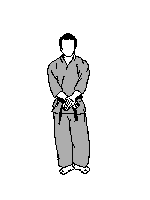 Tensho was developed by Miyagi Chojun Sensei around 1916 after his trip to China, and after intense research into both the Chinese internal systems and the white crane system as practised by his friend Gokenki. Miyagi Sensei is commonly said to have been inspired by the Rokkishu Kata, and the 6 ways to use the hand as described in the bubishi. Tensho follows a similar pattern to that of Sanchin and makes use of smooth flowing actions with the wrists in order to block, re-direct energy, and strike. Again the aim is to harmonize breath with movement, bearing in mind the poem from which the name Goju Ryu derives, Ho goju don tosu – the way of inhaling and exhaling is hard and soft.
Tensho was developed by Miyagi Chojun Sensei around 1916 after his trip to China, and after intense research into both the Chinese internal systems and the white crane system as practised by his friend Gokenki. Miyagi Sensei is commonly said to have been inspired by the Rokkishu Kata, and the 6 ways to use the hand as described in the bubishi. Tensho follows a similar pattern to that of Sanchin and makes use of smooth flowing actions with the wrists in order to block, re-direct energy, and strike. Again the aim is to harmonize breath with movement, bearing in mind the poem from which the name Goju Ryu derives, Ho goju don tosu – the way of inhaling and exhaling is hard and soft.

